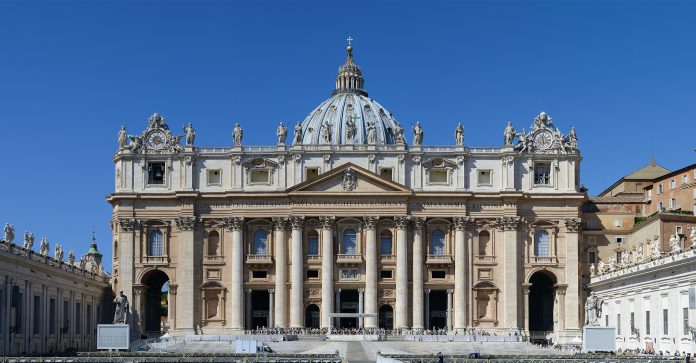The St. Peter’s Basilica is one of the largest and most important churches in the world. Located in Vatican City, it is considered the center of the Catholic Church and the burial place of Saint Peter, one of the twelve apostles of Jesus Christ. The basilica was designed by a number of prominent architects, including Bramante, Michelangelo, and Bernini, and its construction spanned over a century, from 1506 to 1626. In this article, we will explore the architecture of the St. Peter’s Basilica and take a closer look at its interior.
Architecture of St. Peter’s Basilica
The Architecture of St. Peter’s Basilica was built on the site of an earlier church, which had been constructed in the fourth century by Emperor Constantine. The old church had become dilapidated by the fifteenth century, and Pope Julius II decided to rebuild it on a grand scale. He commissioned the architect Donato Bramante to design a new church, which would be one of the largest and most impressive in the world.
Bramante’s design was based on a Greek cross, with a central dome that rose to a height of 138 feet above the floor. The dome was supported by four massive piers, each of which was 60 feet wide. Bramante’s plan was never fully realized, however, as he died in 1514, before the dome was completed.
After Bramante’s death, a number of other architects took over the project, including Raphael, Fra Giocondo, and Antonio da Sangallo the Younger. Each made modifications to the design, adding chapels, naves, and other features. However, it was Michelangelo who made the most significant changes to the design.
Michelangelo was appointed as the chief architect of the St. Peter’s Basilica in 1547. He immediately made changes to Bramante’s plan, raising the dome higher and making it more slender. He also added a narthex, or entrance hall, and a portico, which provided a grand entrance to the basilica. Michelangelo died in 1564, before the dome was completed, and the project was taken over by his assistant, Giacomo della Porta.
Della Porta completed the dome in 1590, raising it to a height of 448 feet above the floor. He also added the lantern, which provides light to the interior of the basilica. The facade of the basilica was designed by Carlo Maderno, who added two bell towers and a central nave that was flanked by two smaller naves. The facade was completed in 1614, and the basilica was officially consecrated in 1626.
The interior of St. Peter’s Basilica
The interior of the St. Peter’s Basilica is as impressive as its exterior. The nave is 693 feet long and 140 feet wide, making it one of the largest spaces in any church. The interior is also richly decorated, with marble, stucco, and gold leaf.
One of the most impressive features of the interior is the dome, which is the largest in the world. It is 138 feet in diameter and rises to a height of 448 feet above the floor. The dome is decorated with mosaics that depict scenes from the life of Christ and the apostles. The base of the dome is surrounded by four large piers, which support the weight of the dome and the lantern.
Another impressive feature of the interior is the baldachin, which is located directly beneath the dome. The baldachin is a large bronze canopy that is supported by four columns. It was designed by Bernini in the seventeenth century and is considered one of the finest examples of Baroque art. Beneath
the baldachin is the high altar, which is the focal point of the basilica. The altar is made of bronze and is decorated with marble and gold leaf. Behind the altar is the apse, which is decorated with mosaics that depict Christ and the apostles.
The interior of the basilica is also home to a number of chapels, each of which is richly decorated. One of the most famous is the Chapel of the Blessed Sacrament, which is located on the right side of the nave. The chapel was designed by Bernini and is home to a large bronze sculpture of the Holy Spirit.
Another famous chapel is the Chapel of the Pietà, which is located on the left side of the nave. The chapel is home to Michelangelo’s famous sculpture of the same name, which depicts the body of Christ after his crucifixion. The sculpture is considered one of the greatest works of art in the world.
The basilica is also home to a number of tombs, including those of a number of popes. The most famous of these is the tomb of Saint Peter, which is located directly beneath the high altar. The tomb is surrounded by a number of other tombs, including those of Pope Pius XI and Pope John Paul II.
The interior of the basilica is also home to a number of other works of art, including paintings, sculptures, and tapestries. One of the most famous is the bronze statue of Saint Peter, which is located in the nave. The statue is traditionally thought to have been created by Arnolfo di Cambio in the thirteenth century.
Conclusion
The St. Peter’s Basilica is a magnificent example of Renaissance and Baroque architecture. Its design and construction spanned over a century and involved some of the most talented architects and artists of the time. The interior of the basilica is equally impressive, with its vast size and rich decoration. The basilica is a testament to the power and influence of the Catholic Church and is a must-visit for anyone interested in art and architecture.






























